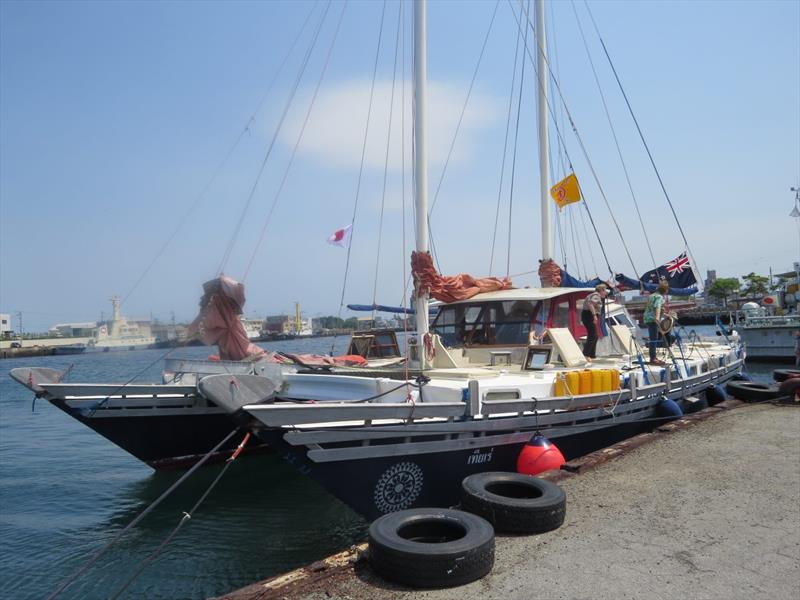
East Asia - Japan
by noonsite.com 6 Mar 2019 23:05 UTC

Tiare © Stephen and Nancy Carlman
Since the relaxation of Japan's closed-port permit system in May of last year and with no clearance fees, it is now so much easier to cruise this enchanting country.
We have been working hard to expand our Japan information, including many new ports, so why not find out about everything Japan and make sure it's on your cruising itinerary for 2019.
Facts
- Japan is an island country in East Asia. It is located in the Pacific Ocean and lies off the eastern coast of the Asian continent. It stretches from the Sea of Okhotsk in the north to the East China Sea and the Philippine Sea in the south.
- The total population of Japan is about 127 million, about 90% of whom live in cities. The majority of the Japanese practice Shintoism or Buddism, or a combination of the two.
- Japan operates on Japan Standard Time. For specifics see General Info.
- Japan has four seasons. Spring is characterised by mild conditions whilst the summers can be hot and humid. Autumn can be unpredictable with the highest chance of typhoons whilst the winters are generally crisp with clear skies and snow in places. See Weather section below for more details.
- A major cruising attraction is the Inland Sea (Seto Naikai), which is a large body of water, connected by three passes to the surrounding ocean, and which allows a yacht access into the very heart of the country. The place abounds with pretty anchorages or small fishing harbours, but there are also many marinas as well as yacht clubs, which usually offer hospitality to visitors. Those in the smaller places have only basic facilities, while in the larger towns clubs are on a par with the best yacht clubs in Europe or America.
- Marinas in the Inland Sea are generally expensive, but some of them offer free berthing to foreign visitors for a few days. There are no charges for tying up to a dock in a commercial or fishing harbour. For more details on yachting services see Yachting Essentials.
- The Kuroshio, or Black Current, flows from south to north and is a very reasonable way for yachts in Asia to take the North Passage to the US West coast. It is easier to cruise the Japanese Islands moving in this direction.
Security
Overall Crime and Safety
Japan is recognised as one of the world's safest countries, so crime levels throughout Japan are low and it is generally safe to use public transport and walk about freely at night. However, reports of inappropriate touching of female passengers on commuter trains are fairly common. The police advise that you shout at the perpetrator to attract attention and ask a fellow passenger to call the train staff.
Specific areas of concern:
Road Safety: Cars drive on the left in Japan and drivers are generally well mannered. However, a common danger on Japanese roads is drivers speeding over intersections, even well after the traffic light has turned red.
Emergency Numbers: See General Info for more details.
Weather
The north is cold, while the south is in the monsoon belt. Most of the country is in a temperate four seasonal zone. Summer sees SE winds and a rainy season in June and July. Typhoons are most frequent mid-July to October, but can occur at any time; five to ten days' warning are usually given. Fog may be a problem at times so having radar is essential. Although typhoons are a constant threat, weather forecasts and faxes are good and reliable, and almost every port has a typhoon shelter.
Japan Meteorological Agency: This is updated twice a day.
A useful link typhoon tracking is: usno.navy.mil/NOOC/nmfc-ph/RSS/jtwc/ab/abpwweb
For links to free global weather information, forecast services and extreme weather information see the Noonsite Weather Page.
Main Ports
Although only those ports listed are actual official ports of entry, in practice visiting yachts could be cleared in any port, as all have the relevant offices. Yachts can be cleared at any port that has customs and immigration offices.
- Gotto Retto Archipelago: Goto (Fukuyama) *, Ukushima
- Inland Sea (Seto Naikai): Aioi *, Nishinomiya, Shimonoseki *, Sumoto (Awaji Island)
- Kyushu: Akune, Fukuoka (Hakata) *, Kagoshim, Kasasa, Makurazaki, Nagasaki *, Nomo Ko
- Mainland (Honshu): Hiroshima City *, Omaezaki, Shimizu *, Shimoda, Tokyo *, Yokohama *
- Okinawa: Iejima, Ishigaki (Okinawa) *, Naha / Ginowan (Okinawa Island) *
- Osaka Bay: Kobe *, Osaka *, Tannowa *, Wakayama *
- Other Islands: Amami Oshima, Hirado, Hokkaido, Ogasawara Islands (Bonin Islands) *, Okinoshima, Sado, Yakushima
*
indicates port of entry
This article has been provided by the courtesy of noonsite.com.